FNN 6800 Financial Performance Management: Environmental Cost Analysis
VerifiedAdded on 2023/01/05
|12
|3837
|42
Report
AI Summary
This report provides an in-depth analysis of financial performance management, focusing on environmental cost accounting and decision-making processes. Part 1 critically discusses the issues businesses face in managing environmental costs, examining methods like input/output analysis, flow cost accounting, and activity-based costing. It also covers how these costs are identified, recorded, and controlled. Part 2 explores the role of management accountants in decision-making, emphasizing the importance of planning tools and management accounting techniques in resolving financial issues such as inconsistency in sales and higher expenses compared to profits. The report highlights the use of cost accounting reports, accounts receivable aging reports, and stock reports to inform managerial decisions, ultimately aiming to improve business performance and financial security. Desklib offers a wealth of similar resources, including past papers and solved assignments, for students seeking to enhance their understanding of these critical concepts.
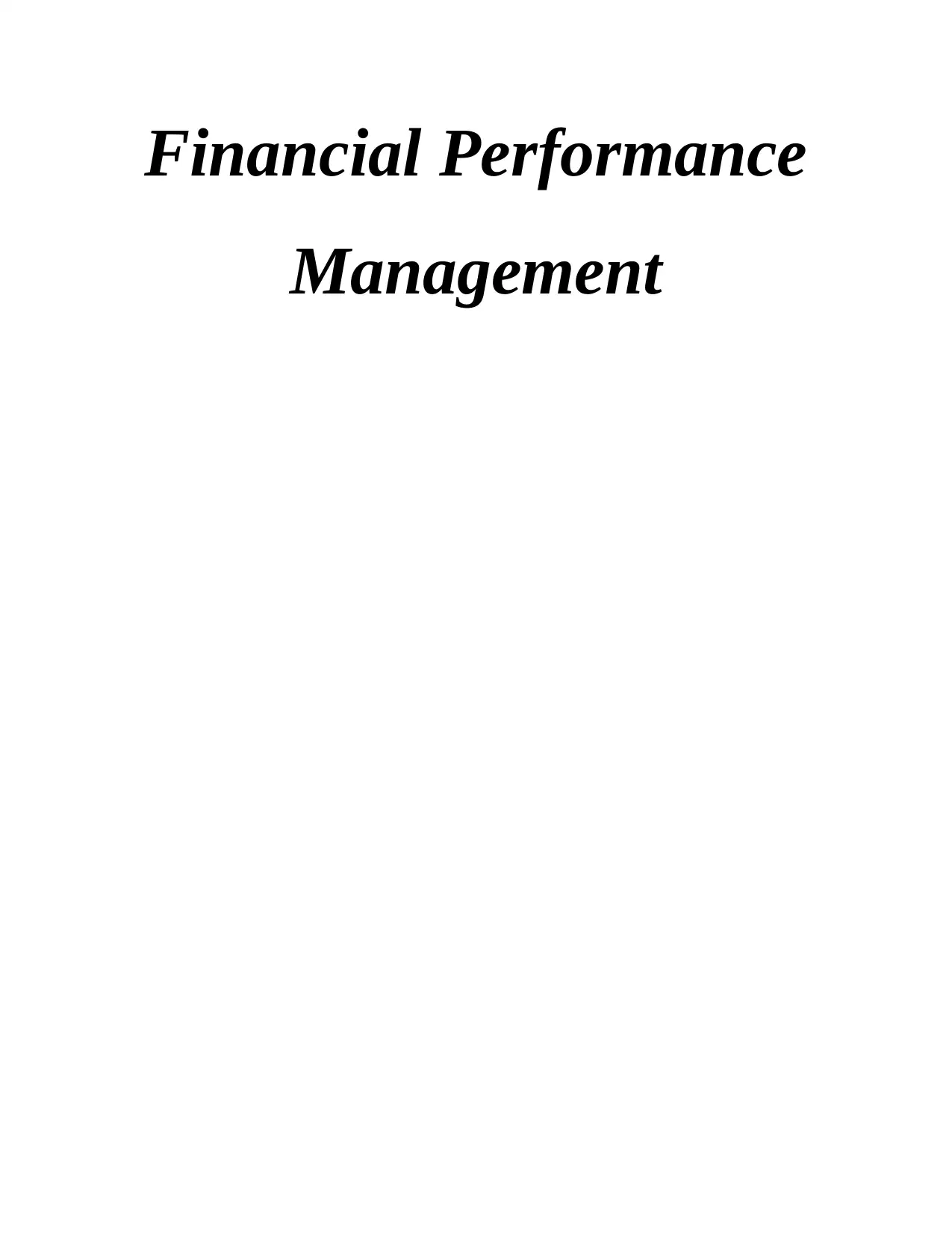
Financial Performance
Management
Management
Paraphrase This Document
Need a fresh take? Get an instant paraphrase of this document with our AI Paraphraser
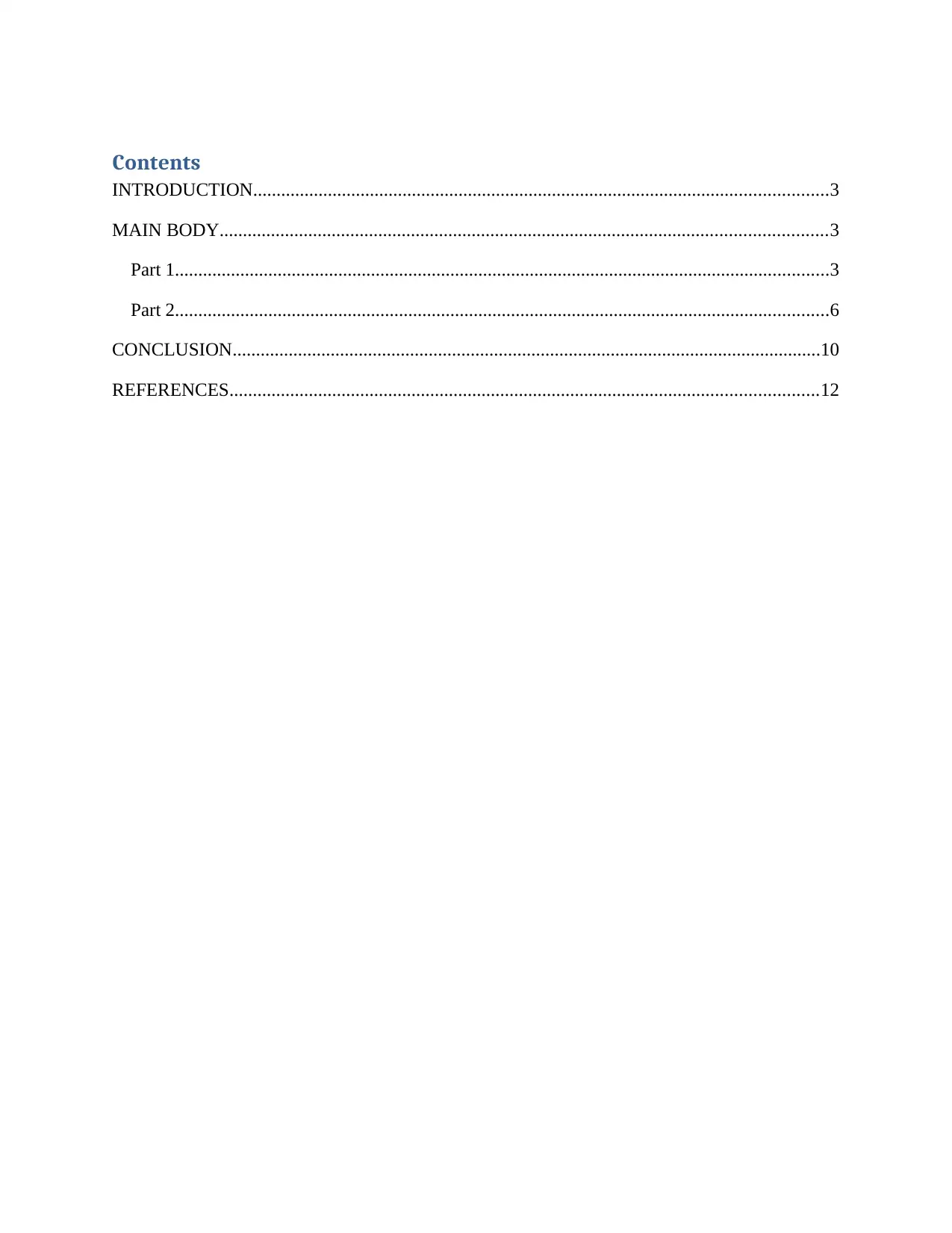
Contents
INTRODUCTION...........................................................................................................................3
MAIN BODY..................................................................................................................................3
Part 1............................................................................................................................................3
Part 2............................................................................................................................................6
CONCLUSION..............................................................................................................................10
REFERENCES..............................................................................................................................12
INTRODUCTION...........................................................................................................................3
MAIN BODY..................................................................................................................................3
Part 1............................................................................................................................................3
Part 2............................................................................................................................................6
CONCLUSION..............................................................................................................................10
REFERENCES..............................................................................................................................12
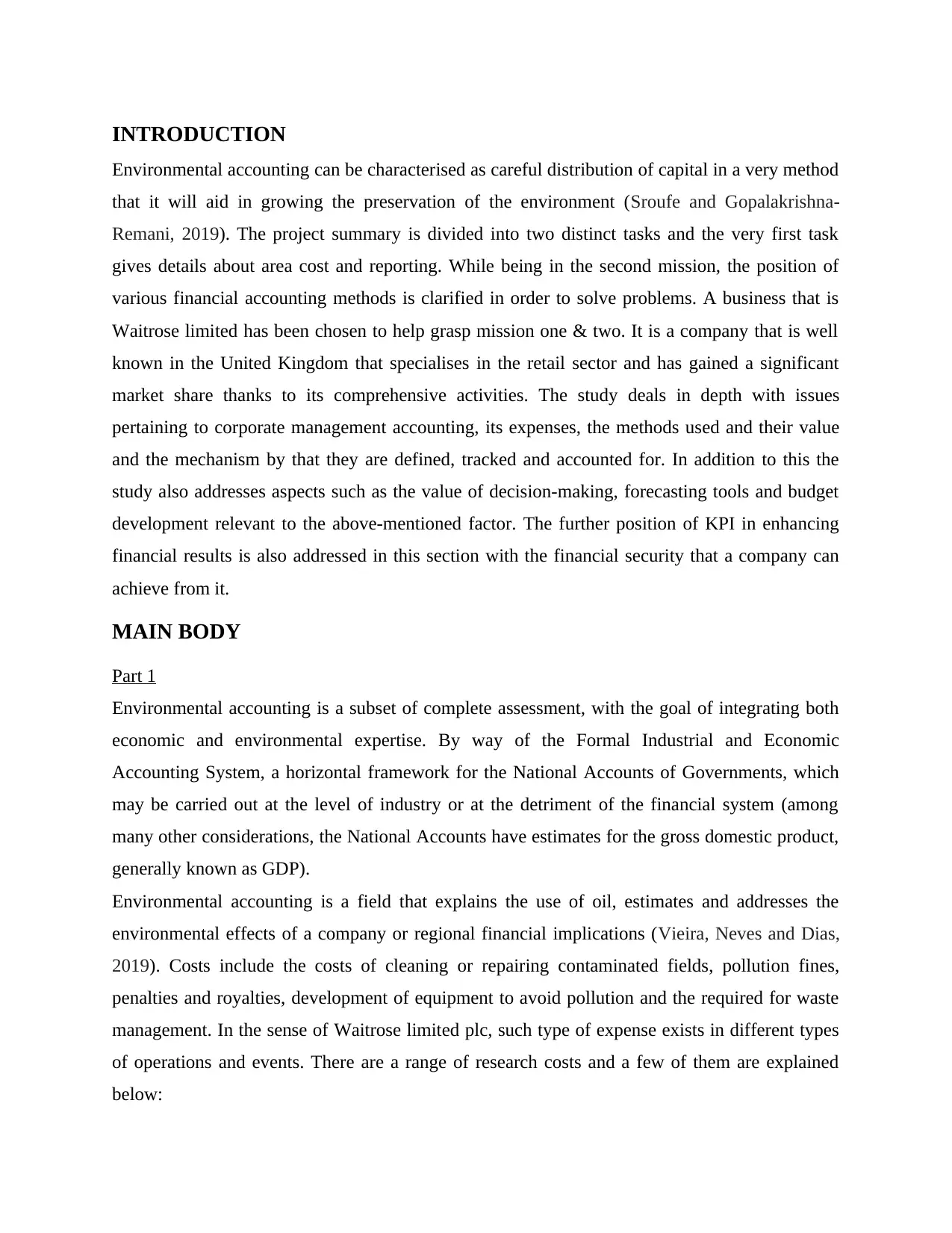
INTRODUCTION
Environmental accounting can be characterised as careful distribution of capital in a very method
that it will aid in growing the preservation of the environment (Sroufe and Gopalakrishna-
Remani, 2019). The project summary is divided into two distinct tasks and the very first task
gives details about area cost and reporting. While being in the second mission, the position of
various financial accounting methods is clarified in order to solve problems. A business that is
Waitrose limited has been chosen to help grasp mission one & two. It is a company that is well
known in the United Kingdom that specialises in the retail sector and has gained a significant
market share thanks to its comprehensive activities. The study deals in depth with issues
pertaining to corporate management accounting, its expenses, the methods used and their value
and the mechanism by that they are defined, tracked and accounted for. In addition to this the
study also addresses aspects such as the value of decision-making, forecasting tools and budget
development relevant to the above-mentioned factor. The further position of KPI in enhancing
financial results is also addressed in this section with the financial security that a company can
achieve from it.
MAIN BODY
Part 1
Environmental accounting is a subset of complete assessment, with the goal of integrating both
economic and environmental expertise. By way of the Formal Industrial and Economic
Accounting System, a horizontal framework for the National Accounts of Governments, which
may be carried out at the level of industry or at the detriment of the financial system (among
many other considerations, the National Accounts have estimates for the gross domestic product,
generally known as GDP).
Environmental accounting is a field that explains the use of oil, estimates and addresses the
environmental effects of a company or regional financial implications (Vieira, Neves and Dias,
2019). Costs include the costs of cleaning or repairing contaminated fields, pollution fines,
penalties and royalties, development of equipment to avoid pollution and the required for waste
management. In the sense of Waitrose limited plc, such type of expense exists in different types
of operations and events. There are a range of research costs and a few of them are explained
below:
Environmental accounting can be characterised as careful distribution of capital in a very method
that it will aid in growing the preservation of the environment (Sroufe and Gopalakrishna-
Remani, 2019). The project summary is divided into two distinct tasks and the very first task
gives details about area cost and reporting. While being in the second mission, the position of
various financial accounting methods is clarified in order to solve problems. A business that is
Waitrose limited has been chosen to help grasp mission one & two. It is a company that is well
known in the United Kingdom that specialises in the retail sector and has gained a significant
market share thanks to its comprehensive activities. The study deals in depth with issues
pertaining to corporate management accounting, its expenses, the methods used and their value
and the mechanism by that they are defined, tracked and accounted for. In addition to this the
study also addresses aspects such as the value of decision-making, forecasting tools and budget
development relevant to the above-mentioned factor. The further position of KPI in enhancing
financial results is also addressed in this section with the financial security that a company can
achieve from it.
MAIN BODY
Part 1
Environmental accounting is a subset of complete assessment, with the goal of integrating both
economic and environmental expertise. By way of the Formal Industrial and Economic
Accounting System, a horizontal framework for the National Accounts of Governments, which
may be carried out at the level of industry or at the detriment of the financial system (among
many other considerations, the National Accounts have estimates for the gross domestic product,
generally known as GDP).
Environmental accounting is a field that explains the use of oil, estimates and addresses the
environmental effects of a company or regional financial implications (Vieira, Neves and Dias,
2019). Costs include the costs of cleaning or repairing contaminated fields, pollution fines,
penalties and royalties, development of equipment to avoid pollution and the required for waste
management. In the sense of Waitrose limited plc, such type of expense exists in different types
of operations and events. There are a range of research costs and a few of them are explained
below:
⊘ This is a preview!⊘
Do you want full access?
Subscribe today to unlock all pages.

Trusted by 1+ million students worldwide
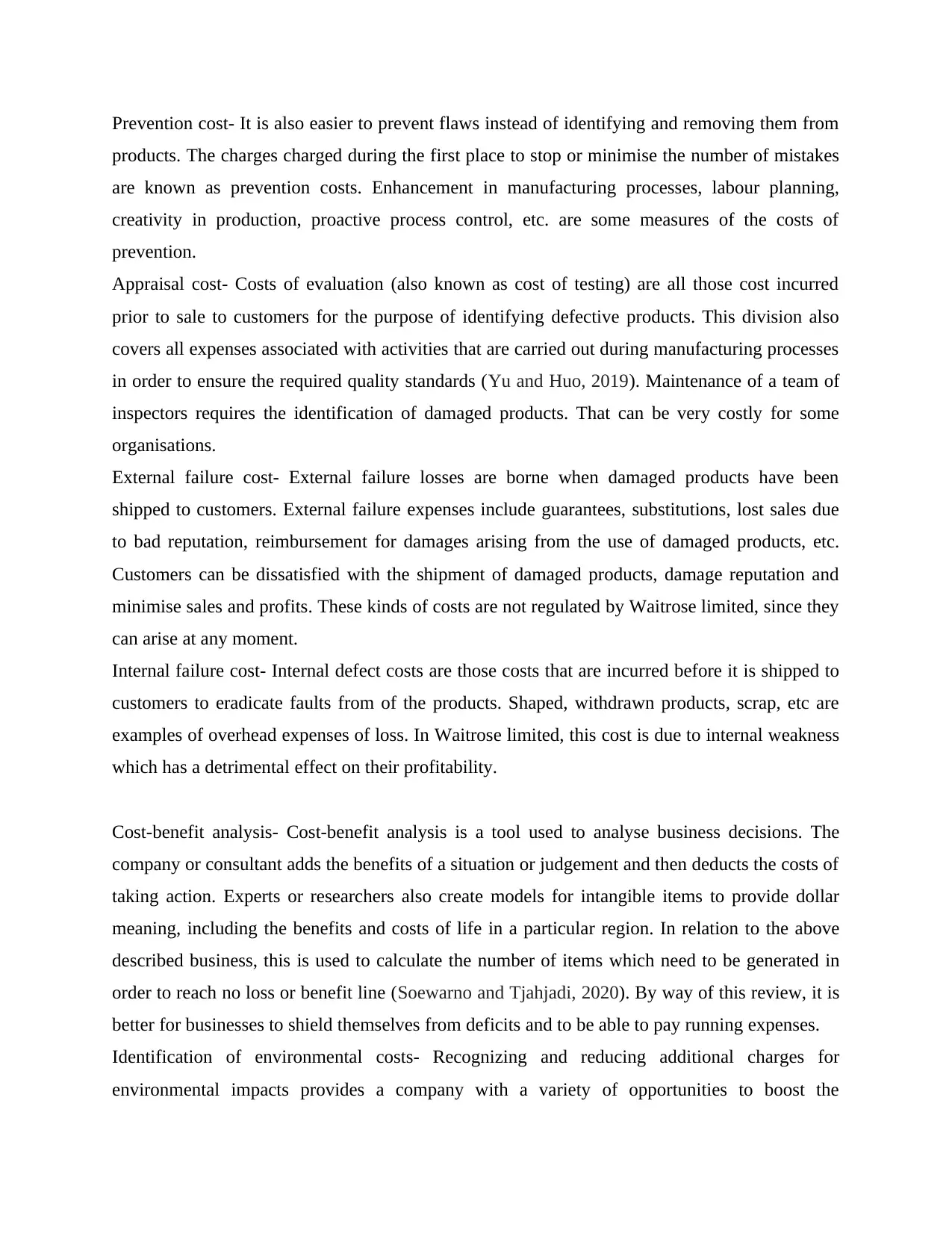
Prevention cost- It is also easier to prevent flaws instead of identifying and removing them from
products. The charges charged during the first place to stop or minimise the number of mistakes
are known as prevention costs. Enhancement in manufacturing processes, labour planning,
creativity in production, proactive process control, etc. are some measures of the costs of
prevention.
Appraisal cost- Costs of evaluation (also known as cost of testing) are all those cost incurred
prior to sale to customers for the purpose of identifying defective products. This division also
covers all expenses associated with activities that are carried out during manufacturing processes
in order to ensure the required quality standards (Yu and Huo, 2019). Maintenance of a team of
inspectors requires the identification of damaged products. That can be very costly for some
organisations.
External failure cost- External failure losses are borne when damaged products have been
shipped to customers. External failure expenses include guarantees, substitutions, lost sales due
to bad reputation, reimbursement for damages arising from the use of damaged products, etc.
Customers can be dissatisfied with the shipment of damaged products, damage reputation and
minimise sales and profits. These kinds of costs are not regulated by Waitrose limited, since they
can arise at any moment.
Internal failure cost- Internal defect costs are those costs that are incurred before it is shipped to
customers to eradicate faults from of the products. Shaped, withdrawn products, scrap, etc are
examples of overhead expenses of loss. In Waitrose limited, this cost is due to internal weakness
which has a detrimental effect on their profitability.
Cost-benefit analysis- Cost-benefit analysis is a tool used to analyse business decisions. The
company or consultant adds the benefits of a situation or judgement and then deducts the costs of
taking action. Experts or researchers also create models for intangible items to provide dollar
meaning, including the benefits and costs of life in a particular region. In relation to the above
described business, this is used to calculate the number of items which need to be generated in
order to reach no loss or benefit line (Soewarno and Tjahjadi, 2020). By way of this review, it is
better for businesses to shield themselves from deficits and to be able to pay running expenses.
Identification of environmental costs- Recognizing and reducing additional charges for
environmental impacts provides a company with a variety of opportunities to boost the
products. The charges charged during the first place to stop or minimise the number of mistakes
are known as prevention costs. Enhancement in manufacturing processes, labour planning,
creativity in production, proactive process control, etc. are some measures of the costs of
prevention.
Appraisal cost- Costs of evaluation (also known as cost of testing) are all those cost incurred
prior to sale to customers for the purpose of identifying defective products. This division also
covers all expenses associated with activities that are carried out during manufacturing processes
in order to ensure the required quality standards (Yu and Huo, 2019). Maintenance of a team of
inspectors requires the identification of damaged products. That can be very costly for some
organisations.
External failure cost- External failure losses are borne when damaged products have been
shipped to customers. External failure expenses include guarantees, substitutions, lost sales due
to bad reputation, reimbursement for damages arising from the use of damaged products, etc.
Customers can be dissatisfied with the shipment of damaged products, damage reputation and
minimise sales and profits. These kinds of costs are not regulated by Waitrose limited, since they
can arise at any moment.
Internal failure cost- Internal defect costs are those costs that are incurred before it is shipped to
customers to eradicate faults from of the products. Shaped, withdrawn products, scrap, etc are
examples of overhead expenses of loss. In Waitrose limited, this cost is due to internal weakness
which has a detrimental effect on their profitability.
Cost-benefit analysis- Cost-benefit analysis is a tool used to analyse business decisions. The
company or consultant adds the benefits of a situation or judgement and then deducts the costs of
taking action. Experts or researchers also create models for intangible items to provide dollar
meaning, including the benefits and costs of life in a particular region. In relation to the above
described business, this is used to calculate the number of items which need to be generated in
order to reach no loss or benefit line (Soewarno and Tjahjadi, 2020). By way of this review, it is
better for businesses to shield themselves from deficits and to be able to pay running expenses.
Identification of environmental costs- Recognizing and reducing additional charges for
environmental impacts provides a company with a variety of opportunities to boost the
Paraphrase This Document
Need a fresh take? Get an instant paraphrase of this document with our AI Paraphraser
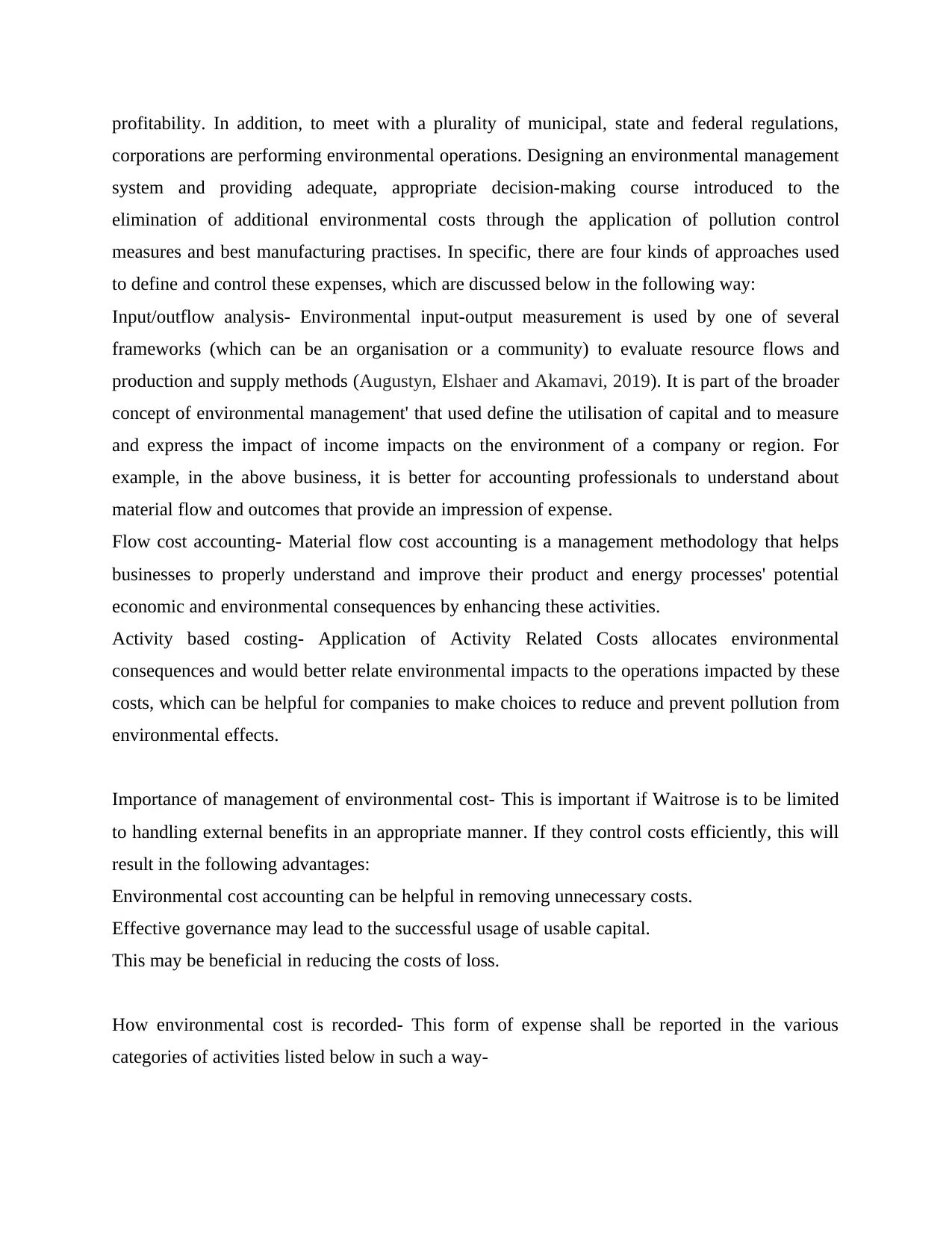
profitability. In addition, to meet with a plurality of municipal, state and federal regulations,
corporations are performing environmental operations. Designing an environmental management
system and providing adequate, appropriate decision-making course introduced to the
elimination of additional environmental costs through the application of pollution control
measures and best manufacturing practises. In specific, there are four kinds of approaches used
to define and control these expenses, which are discussed below in the following way:
Input/outflow analysis- Environmental input-output measurement is used by one of several
frameworks (which can be an organisation or a community) to evaluate resource flows and
production and supply methods (Augustyn, Elshaer and Akamavi, 2019). It is part of the broader
concept of environmental management' that used define the utilisation of capital and to measure
and express the impact of income impacts on the environment of a company or region. For
example, in the above business, it is better for accounting professionals to understand about
material flow and outcomes that provide an impression of expense.
Flow cost accounting- Material flow cost accounting is a management methodology that helps
businesses to properly understand and improve their product and energy processes' potential
economic and environmental consequences by enhancing these activities.
Activity based costing- Application of Activity Related Costs allocates environmental
consequences and would better relate environmental impacts to the operations impacted by these
costs, which can be helpful for companies to make choices to reduce and prevent pollution from
environmental effects.
Importance of management of environmental cost- This is important if Waitrose is to be limited
to handling external benefits in an appropriate manner. If they control costs efficiently, this will
result in the following advantages:
Environmental cost accounting can be helpful in removing unnecessary costs.
Effective governance may lead to the successful usage of usable capital.
This may be beneficial in reducing the costs of loss.
How environmental cost is recorded- This form of expense shall be reported in the various
categories of activities listed below in such a way-
corporations are performing environmental operations. Designing an environmental management
system and providing adequate, appropriate decision-making course introduced to the
elimination of additional environmental costs through the application of pollution control
measures and best manufacturing practises. In specific, there are four kinds of approaches used
to define and control these expenses, which are discussed below in the following way:
Input/outflow analysis- Environmental input-output measurement is used by one of several
frameworks (which can be an organisation or a community) to evaluate resource flows and
production and supply methods (Augustyn, Elshaer and Akamavi, 2019). It is part of the broader
concept of environmental management' that used define the utilisation of capital and to measure
and express the impact of income impacts on the environment of a company or region. For
example, in the above business, it is better for accounting professionals to understand about
material flow and outcomes that provide an impression of expense.
Flow cost accounting- Material flow cost accounting is a management methodology that helps
businesses to properly understand and improve their product and energy processes' potential
economic and environmental consequences by enhancing these activities.
Activity based costing- Application of Activity Related Costs allocates environmental
consequences and would better relate environmental impacts to the operations impacted by these
costs, which can be helpful for companies to make choices to reduce and prevent pollution from
environmental effects.
Importance of management of environmental cost- This is important if Waitrose is to be limited
to handling external benefits in an appropriate manner. If they control costs efficiently, this will
result in the following advantages:
Environmental cost accounting can be helpful in removing unnecessary costs.
Effective governance may lead to the successful usage of usable capital.
This may be beneficial in reducing the costs of loss.
How environmental cost is recorded- This form of expense shall be reported in the various
categories of activities listed below in such a way-
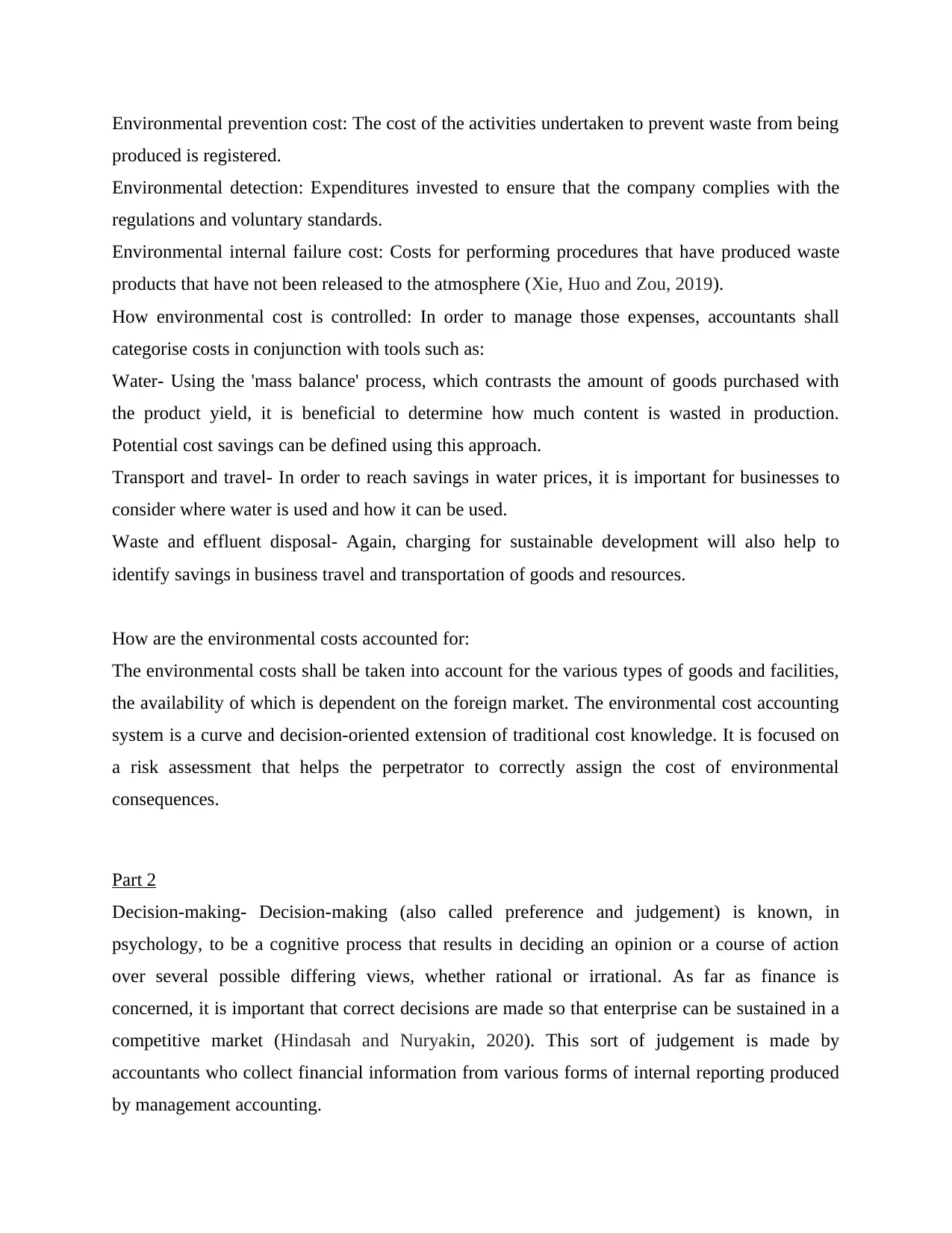
Environmental prevention cost: The cost of the activities undertaken to prevent waste from being
produced is registered.
Environmental detection: Expenditures invested to ensure that the company complies with the
regulations and voluntary standards.
Environmental internal failure cost: Costs for performing procedures that have produced waste
products that have not been released to the atmosphere (Xie, Huo and Zou, 2019).
How environmental cost is controlled: In order to manage those expenses, accountants shall
categorise costs in conjunction with tools such as:
Water- Using the 'mass balance' process, which contrasts the amount of goods purchased with
the product yield, it is beneficial to determine how much content is wasted in production.
Potential cost savings can be defined using this approach.
Transport and travel- In order to reach savings in water prices, it is important for businesses to
consider where water is used and how it can be used.
Waste and effluent disposal- Again, charging for sustainable development will also help to
identify savings in business travel and transportation of goods and resources.
How are the environmental costs accounted for:
The environmental costs shall be taken into account for the various types of goods and facilities,
the availability of which is dependent on the foreign market. The environmental cost accounting
system is a curve and decision-oriented extension of traditional cost knowledge. It is focused on
a risk assessment that helps the perpetrator to correctly assign the cost of environmental
consequences.
Part 2
Decision-making- Decision-making (also called preference and judgement) is known, in
psychology, to be a cognitive process that results in deciding an opinion or a course of action
over several possible differing views, whether rational or irrational. As far as finance is
concerned, it is important that correct decisions are made so that enterprise can be sustained in a
competitive market (Hindasah and Nuryakin, 2020). This sort of judgement is made by
accountants who collect financial information from various forms of internal reporting produced
by management accounting.
produced is registered.
Environmental detection: Expenditures invested to ensure that the company complies with the
regulations and voluntary standards.
Environmental internal failure cost: Costs for performing procedures that have produced waste
products that have not been released to the atmosphere (Xie, Huo and Zou, 2019).
How environmental cost is controlled: In order to manage those expenses, accountants shall
categorise costs in conjunction with tools such as:
Water- Using the 'mass balance' process, which contrasts the amount of goods purchased with
the product yield, it is beneficial to determine how much content is wasted in production.
Potential cost savings can be defined using this approach.
Transport and travel- In order to reach savings in water prices, it is important for businesses to
consider where water is used and how it can be used.
Waste and effluent disposal- Again, charging for sustainable development will also help to
identify savings in business travel and transportation of goods and resources.
How are the environmental costs accounted for:
The environmental costs shall be taken into account for the various types of goods and facilities,
the availability of which is dependent on the foreign market. The environmental cost accounting
system is a curve and decision-oriented extension of traditional cost knowledge. It is focused on
a risk assessment that helps the perpetrator to correctly assign the cost of environmental
consequences.
Part 2
Decision-making- Decision-making (also called preference and judgement) is known, in
psychology, to be a cognitive process that results in deciding an opinion or a course of action
over several possible differing views, whether rational or irrational. As far as finance is
concerned, it is important that correct decisions are made so that enterprise can be sustained in a
competitive market (Hindasah and Nuryakin, 2020). This sort of judgement is made by
accountants who collect financial information from various forms of internal reporting produced
by management accounting.
⊘ This is a preview!⊘
Do you want full access?
Subscribe today to unlock all pages.

Trusted by 1+ million students worldwide
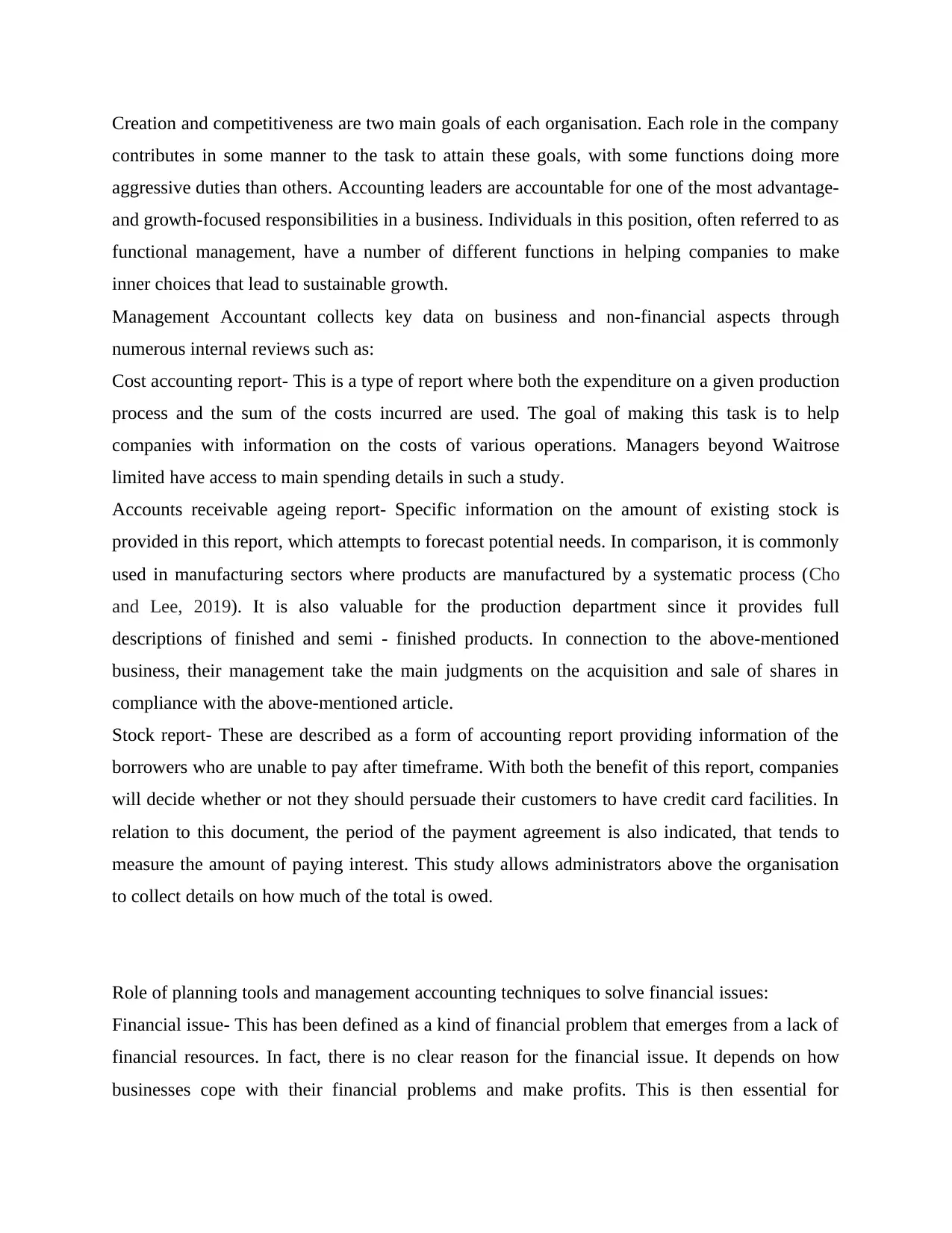
Creation and competitiveness are two main goals of each organisation. Each role in the company
contributes in some manner to the task to attain these goals, with some functions doing more
aggressive duties than others. Accounting leaders are accountable for one of the most advantage-
and growth-focused responsibilities in a business. Individuals in this position, often referred to as
functional management, have a number of different functions in helping companies to make
inner choices that lead to sustainable growth.
Management Accountant collects key data on business and non-financial aspects through
numerous internal reviews such as:
Cost accounting report- This is a type of report where both the expenditure on a given production
process and the sum of the costs incurred are used. The goal of making this task is to help
companies with information on the costs of various operations. Managers beyond Waitrose
limited have access to main spending details in such a study.
Accounts receivable ageing report- Specific information on the amount of existing stock is
provided in this report, which attempts to forecast potential needs. In comparison, it is commonly
used in manufacturing sectors where products are manufactured by a systematic process (Cho
and Lee, 2019). It is also valuable for the production department since it provides full
descriptions of finished and semi - finished products. In connection to the above-mentioned
business, their management take the main judgments on the acquisition and sale of shares in
compliance with the above-mentioned article.
Stock report- These are described as a form of accounting report providing information of the
borrowers who are unable to pay after timeframe. With both the benefit of this report, companies
will decide whether or not they should persuade their customers to have credit card facilities. In
relation to this document, the period of the payment agreement is also indicated, that tends to
measure the amount of paying interest. This study allows administrators above the organisation
to collect details on how much of the total is owed.
Role of planning tools and management accounting techniques to solve financial issues:
Financial issue- This has been defined as a kind of financial problem that emerges from a lack of
financial resources. In fact, there is no clear reason for the financial issue. It depends on how
businesses cope with their financial problems and make profits. This is then essential for
contributes in some manner to the task to attain these goals, with some functions doing more
aggressive duties than others. Accounting leaders are accountable for one of the most advantage-
and growth-focused responsibilities in a business. Individuals in this position, often referred to as
functional management, have a number of different functions in helping companies to make
inner choices that lead to sustainable growth.
Management Accountant collects key data on business and non-financial aspects through
numerous internal reviews such as:
Cost accounting report- This is a type of report where both the expenditure on a given production
process and the sum of the costs incurred are used. The goal of making this task is to help
companies with information on the costs of various operations. Managers beyond Waitrose
limited have access to main spending details in such a study.
Accounts receivable ageing report- Specific information on the amount of existing stock is
provided in this report, which attempts to forecast potential needs. In comparison, it is commonly
used in manufacturing sectors where products are manufactured by a systematic process (Cho
and Lee, 2019). It is also valuable for the production department since it provides full
descriptions of finished and semi - finished products. In connection to the above-mentioned
business, their management take the main judgments on the acquisition and sale of shares in
compliance with the above-mentioned article.
Stock report- These are described as a form of accounting report providing information of the
borrowers who are unable to pay after timeframe. With both the benefit of this report, companies
will decide whether or not they should persuade their customers to have credit card facilities. In
relation to this document, the period of the payment agreement is also indicated, that tends to
measure the amount of paying interest. This study allows administrators above the organisation
to collect details on how much of the total is owed.
Role of planning tools and management accounting techniques to solve financial issues:
Financial issue- This has been defined as a kind of financial problem that emerges from a lack of
financial resources. In fact, there is no clear reason for the financial issue. It depends on how
businesses cope with their financial problems and make profits. This is then essential for
Paraphrase This Document
Need a fresh take? Get an instant paraphrase of this document with our AI Paraphraser
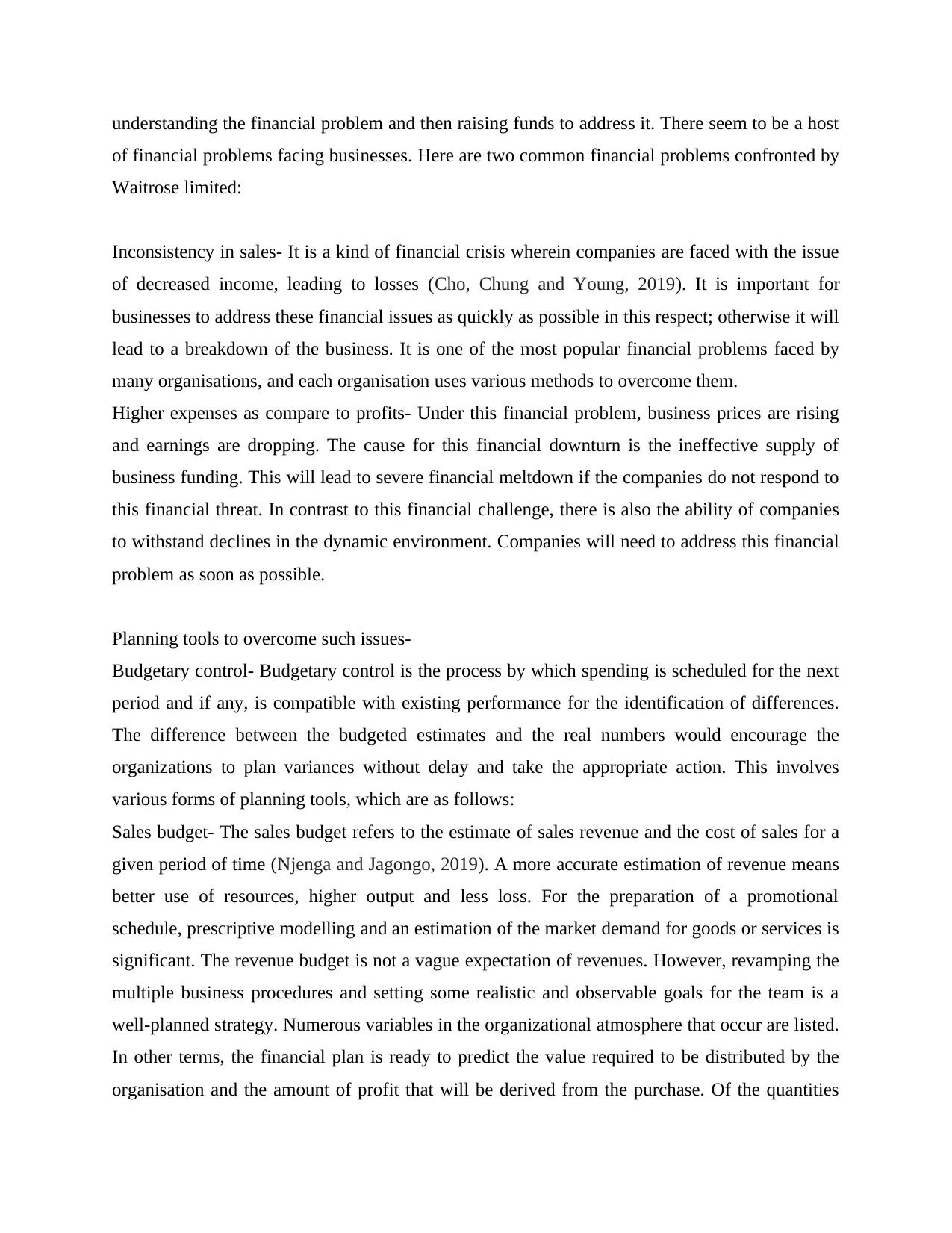
understanding the financial problem and then raising funds to address it. There seem to be a host
of financial problems facing businesses. Here are two common financial problems confronted by
Waitrose limited:
Inconsistency in sales- It is a kind of financial crisis wherein companies are faced with the issue
of decreased income, leading to losses (Cho, Chung and Young, 2019). It is important for
businesses to address these financial issues as quickly as possible in this respect; otherwise it will
lead to a breakdown of the business. It is one of the most popular financial problems faced by
many organisations, and each organisation uses various methods to overcome them.
Higher expenses as compare to profits- Under this financial problem, business prices are rising
and earnings are dropping. The cause for this financial downturn is the ineffective supply of
business funding. This will lead to severe financial meltdown if the companies do not respond to
this financial threat. In contrast to this financial challenge, there is also the ability of companies
to withstand declines in the dynamic environment. Companies will need to address this financial
problem as soon as possible.
Planning tools to overcome such issues-
Budgetary control- Budgetary control is the process by which spending is scheduled for the next
period and if any, is compatible with existing performance for the identification of differences.
The difference between the budgeted estimates and the real numbers would encourage the
organizations to plan variances without delay and take the appropriate action. This involves
various forms of planning tools, which are as follows:
Sales budget- The sales budget refers to the estimate of sales revenue and the cost of sales for a
given period of time (Njenga and Jagongo, 2019). A more accurate estimation of revenue means
better use of resources, higher output and less loss. For the preparation of a promotional
schedule, prescriptive modelling and an estimation of the market demand for goods or services is
significant. The revenue budget is not a vague expectation of revenues. However, revamping the
multiple business procedures and setting some realistic and observable goals for the team is a
well-planned strategy. Numerous variables in the organizational atmosphere that occur are listed.
In other terms, the financial plan is ready to predict the value required to be distributed by the
organisation and the amount of profit that will be derived from the purchase. Of the quantities
of financial problems facing businesses. Here are two common financial problems confronted by
Waitrose limited:
Inconsistency in sales- It is a kind of financial crisis wherein companies are faced with the issue
of decreased income, leading to losses (Cho, Chung and Young, 2019). It is important for
businesses to address these financial issues as quickly as possible in this respect; otherwise it will
lead to a breakdown of the business. It is one of the most popular financial problems faced by
many organisations, and each organisation uses various methods to overcome them.
Higher expenses as compare to profits- Under this financial problem, business prices are rising
and earnings are dropping. The cause for this financial downturn is the ineffective supply of
business funding. This will lead to severe financial meltdown if the companies do not respond to
this financial threat. In contrast to this financial challenge, there is also the ability of companies
to withstand declines in the dynamic environment. Companies will need to address this financial
problem as soon as possible.
Planning tools to overcome such issues-
Budgetary control- Budgetary control is the process by which spending is scheduled for the next
period and if any, is compatible with existing performance for the identification of differences.
The difference between the budgeted estimates and the real numbers would encourage the
organizations to plan variances without delay and take the appropriate action. This involves
various forms of planning tools, which are as follows:
Sales budget- The sales budget refers to the estimate of sales revenue and the cost of sales for a
given period of time (Njenga and Jagongo, 2019). A more accurate estimation of revenue means
better use of resources, higher output and less loss. For the preparation of a promotional
schedule, prescriptive modelling and an estimation of the market demand for goods or services is
significant. The revenue budget is not a vague expectation of revenues. However, revamping the
multiple business procedures and setting some realistic and observable goals for the team is a
well-planned strategy. Numerous variables in the organizational atmosphere that occur are listed.
In other terms, the financial plan is ready to predict the value required to be distributed by the
organisation and the amount of profit that will be derived from the purchase. Of the quantities
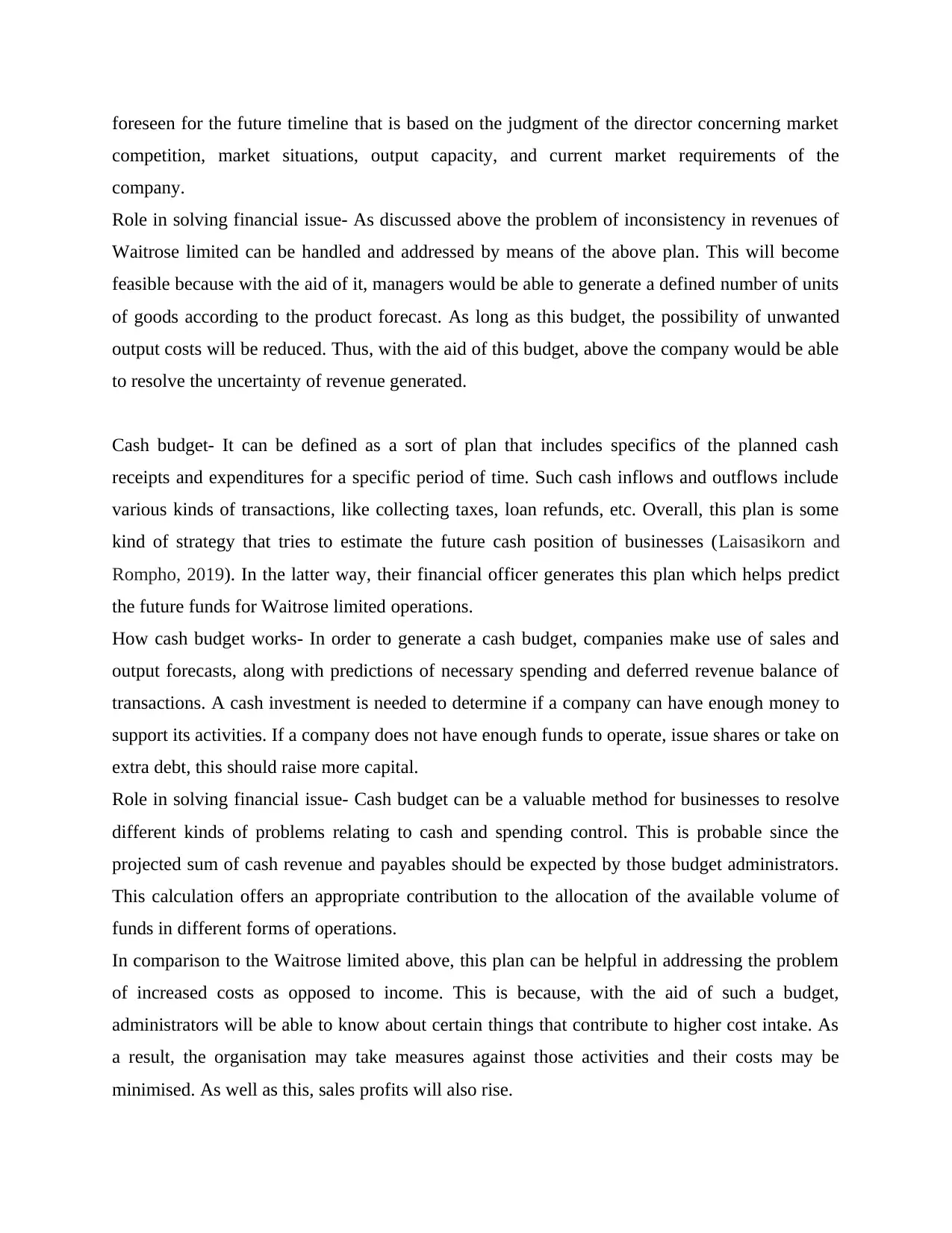
foreseen for the future timeline that is based on the judgment of the director concerning market
competition, market situations, output capacity, and current market requirements of the
company.
Role in solving financial issue- As discussed above the problem of inconsistency in revenues of
Waitrose limited can be handled and addressed by means of the above plan. This will become
feasible because with the aid of it, managers would be able to generate a defined number of units
of goods according to the product forecast. As long as this budget, the possibility of unwanted
output costs will be reduced. Thus, with the aid of this budget, above the company would be able
to resolve the uncertainty of revenue generated.
Cash budget- It can be defined as a sort of plan that includes specifics of the planned cash
receipts and expenditures for a specific period of time. Such cash inflows and outflows include
various kinds of transactions, like collecting taxes, loan refunds, etc. Overall, this plan is some
kind of strategy that tries to estimate the future cash position of businesses (Laisasikorn and
Rompho, 2019). In the latter way, their financial officer generates this plan which helps predict
the future funds for Waitrose limited operations.
How cash budget works- In order to generate a cash budget, companies make use of sales and
output forecasts, along with predictions of necessary spending and deferred revenue balance of
transactions. A cash investment is needed to determine if a company can have enough money to
support its activities. If a company does not have enough funds to operate, issue shares or take on
extra debt, this should raise more capital.
Role in solving financial issue- Cash budget can be a valuable method for businesses to resolve
different kinds of problems relating to cash and spending control. This is probable since the
projected sum of cash revenue and payables should be expected by those budget administrators.
This calculation offers an appropriate contribution to the allocation of the available volume of
funds in different forms of operations.
In comparison to the Waitrose limited above, this plan can be helpful in addressing the problem
of increased costs as opposed to income. This is because, with the aid of such a budget,
administrators will be able to know about certain things that contribute to higher cost intake. As
a result, the organisation may take measures against those activities and their costs may be
minimised. As well as this, sales profits will also rise.
competition, market situations, output capacity, and current market requirements of the
company.
Role in solving financial issue- As discussed above the problem of inconsistency in revenues of
Waitrose limited can be handled and addressed by means of the above plan. This will become
feasible because with the aid of it, managers would be able to generate a defined number of units
of goods according to the product forecast. As long as this budget, the possibility of unwanted
output costs will be reduced. Thus, with the aid of this budget, above the company would be able
to resolve the uncertainty of revenue generated.
Cash budget- It can be defined as a sort of plan that includes specifics of the planned cash
receipts and expenditures for a specific period of time. Such cash inflows and outflows include
various kinds of transactions, like collecting taxes, loan refunds, etc. Overall, this plan is some
kind of strategy that tries to estimate the future cash position of businesses (Laisasikorn and
Rompho, 2019). In the latter way, their financial officer generates this plan which helps predict
the future funds for Waitrose limited operations.
How cash budget works- In order to generate a cash budget, companies make use of sales and
output forecasts, along with predictions of necessary spending and deferred revenue balance of
transactions. A cash investment is needed to determine if a company can have enough money to
support its activities. If a company does not have enough funds to operate, issue shares or take on
extra debt, this should raise more capital.
Role in solving financial issue- Cash budget can be a valuable method for businesses to resolve
different kinds of problems relating to cash and spending control. This is probable since the
projected sum of cash revenue and payables should be expected by those budget administrators.
This calculation offers an appropriate contribution to the allocation of the available volume of
funds in different forms of operations.
In comparison to the Waitrose limited above, this plan can be helpful in addressing the problem
of increased costs as opposed to income. This is because, with the aid of such a budget,
administrators will be able to know about certain things that contribute to higher cost intake. As
a result, the organisation may take measures against those activities and their costs may be
minimised. As well as this, sales profits will also rise.
⊘ This is a preview!⊘
Do you want full access?
Subscribe today to unlock all pages.

Trusted by 1+ million students worldwide
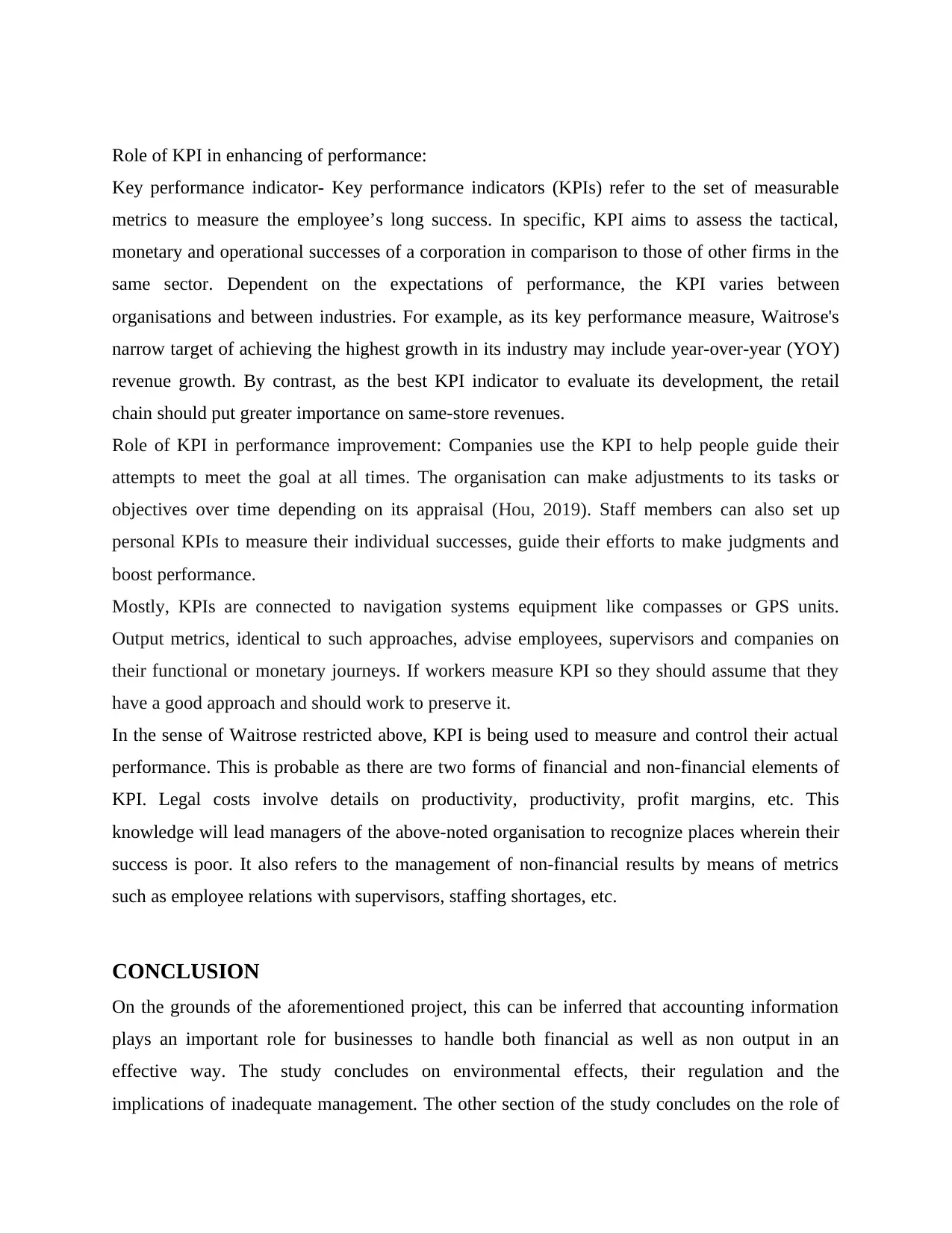
Role of KPI in enhancing of performance:
Key performance indicator- Key performance indicators (KPIs) refer to the set of measurable
metrics to measure the employee’s long success. In specific, KPI aims to assess the tactical,
monetary and operational successes of a corporation in comparison to those of other firms in the
same sector. Dependent on the expectations of performance, the KPI varies between
organisations and between industries. For example, as its key performance measure, Waitrose's
narrow target of achieving the highest growth in its industry may include year-over-year (YOY)
revenue growth. By contrast, as the best KPI indicator to evaluate its development, the retail
chain should put greater importance on same-store revenues.
Role of KPI in performance improvement: Companies use the KPI to help people guide their
attempts to meet the goal at all times. The organisation can make adjustments to its tasks or
objectives over time depending on its appraisal (Hou, 2019). Staff members can also set up
personal KPIs to measure their individual successes, guide their efforts to make judgments and
boost performance.
Mostly, KPIs are connected to navigation systems equipment like compasses or GPS units.
Output metrics, identical to such approaches, advise employees, supervisors and companies on
their functional or monetary journeys. If workers measure KPI so they should assume that they
have a good approach and should work to preserve it.
In the sense of Waitrose restricted above, KPI is being used to measure and control their actual
performance. This is probable as there are two forms of financial and non-financial elements of
KPI. Legal costs involve details on productivity, productivity, profit margins, etc. This
knowledge will lead managers of the above-noted organisation to recognize places wherein their
success is poor. It also refers to the management of non-financial results by means of metrics
such as employee relations with supervisors, staffing shortages, etc.
CONCLUSION
On the grounds of the aforementioned project, this can be inferred that accounting information
plays an important role for businesses to handle both financial as well as non output in an
effective way. The study concludes on environmental effects, their regulation and the
implications of inadequate management. The other section of the study concludes on the role of
Key performance indicator- Key performance indicators (KPIs) refer to the set of measurable
metrics to measure the employee’s long success. In specific, KPI aims to assess the tactical,
monetary and operational successes of a corporation in comparison to those of other firms in the
same sector. Dependent on the expectations of performance, the KPI varies between
organisations and between industries. For example, as its key performance measure, Waitrose's
narrow target of achieving the highest growth in its industry may include year-over-year (YOY)
revenue growth. By contrast, as the best KPI indicator to evaluate its development, the retail
chain should put greater importance on same-store revenues.
Role of KPI in performance improvement: Companies use the KPI to help people guide their
attempts to meet the goal at all times. The organisation can make adjustments to its tasks or
objectives over time depending on its appraisal (Hou, 2019). Staff members can also set up
personal KPIs to measure their individual successes, guide their efforts to make judgments and
boost performance.
Mostly, KPIs are connected to navigation systems equipment like compasses or GPS units.
Output metrics, identical to such approaches, advise employees, supervisors and companies on
their functional or monetary journeys. If workers measure KPI so they should assume that they
have a good approach and should work to preserve it.
In the sense of Waitrose restricted above, KPI is being used to measure and control their actual
performance. This is probable as there are two forms of financial and non-financial elements of
KPI. Legal costs involve details on productivity, productivity, profit margins, etc. This
knowledge will lead managers of the above-noted organisation to recognize places wherein their
success is poor. It also refers to the management of non-financial results by means of metrics
such as employee relations with supervisors, staffing shortages, etc.
CONCLUSION
On the grounds of the aforementioned project, this can be inferred that accounting information
plays an important role for businesses to handle both financial as well as non output in an
effective way. The study concludes on environmental effects, their regulation and the
implications of inadequate management. The other section of the study concludes on the role of
Paraphrase This Document
Need a fresh take? Get an instant paraphrase of this document with our AI Paraphraser

preparation resources to resolve the financial issue. The study contains numerous forms of
forecasting resources, such as the revenue budget, the cash budget, and so many more. In
comparison, the value of main performance metrics, both financial and non-financial measures,
is also clarified in the paper.
forecasting resources, such as the revenue budget, the cash budget, and so many more. In
comparison, the value of main performance metrics, both financial and non-financial measures,
is also clarified in the paper.
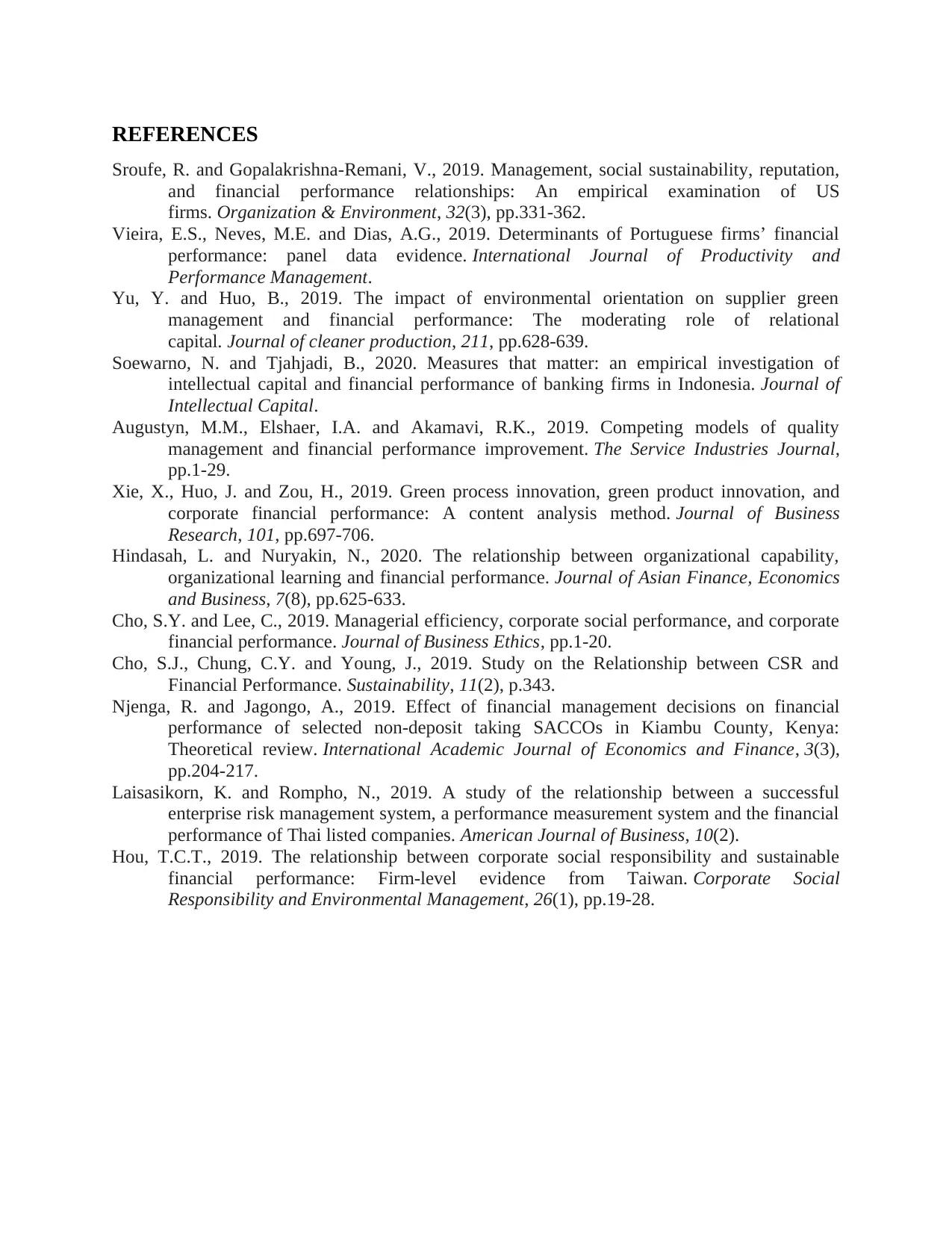
REFERENCES
Sroufe, R. and Gopalakrishna-Remani, V., 2019. Management, social sustainability, reputation,
and financial performance relationships: An empirical examination of US
firms. Organization & Environment, 32(3), pp.331-362.
Vieira, E.S., Neves, M.E. and Dias, A.G., 2019. Determinants of Portuguese firms’ financial
performance: panel data evidence. International Journal of Productivity and
Performance Management.
Yu, Y. and Huo, B., 2019. The impact of environmental orientation on supplier green
management and financial performance: The moderating role of relational
capital. Journal of cleaner production, 211, pp.628-639.
Soewarno, N. and Tjahjadi, B., 2020. Measures that matter: an empirical investigation of
intellectual capital and financial performance of banking firms in Indonesia. Journal of
Intellectual Capital.
Augustyn, M.M., Elshaer, I.A. and Akamavi, R.K., 2019. Competing models of quality
management and financial performance improvement. The Service Industries Journal,
pp.1-29.
Xie, X., Huo, J. and Zou, H., 2019. Green process innovation, green product innovation, and
corporate financial performance: A content analysis method. Journal of Business
Research, 101, pp.697-706.
Hindasah, L. and Nuryakin, N., 2020. The relationship between organizational capability,
organizational learning and financial performance. Journal of Asian Finance, Economics
and Business, 7(8), pp.625-633.
Cho, S.Y. and Lee, C., 2019. Managerial efficiency, corporate social performance, and corporate
financial performance. Journal of Business Ethics, pp.1-20.
Cho, S.J., Chung, C.Y. and Young, J., 2019. Study on the Relationship between CSR and
Financial Performance. Sustainability, 11(2), p.343.
Njenga, R. and Jagongo, A., 2019. Effect of financial management decisions on financial
performance of selected non-deposit taking SACCOs in Kiambu County, Kenya:
Theoretical review. International Academic Journal of Economics and Finance, 3(3),
pp.204-217.
Laisasikorn, K. and Rompho, N., 2019. A study of the relationship between a successful
enterprise risk management system, a performance measurement system and the financial
performance of Thai listed companies. American Journal of Business, 10(2).
Hou, T.C.T., 2019. The relationship between corporate social responsibility and sustainable
financial performance: Firm‐level evidence from Taiwan. Corporate Social
Responsibility and Environmental Management, 26(1), pp.19-28.
Sroufe, R. and Gopalakrishna-Remani, V., 2019. Management, social sustainability, reputation,
and financial performance relationships: An empirical examination of US
firms. Organization & Environment, 32(3), pp.331-362.
Vieira, E.S., Neves, M.E. and Dias, A.G., 2019. Determinants of Portuguese firms’ financial
performance: panel data evidence. International Journal of Productivity and
Performance Management.
Yu, Y. and Huo, B., 2019. The impact of environmental orientation on supplier green
management and financial performance: The moderating role of relational
capital. Journal of cleaner production, 211, pp.628-639.
Soewarno, N. and Tjahjadi, B., 2020. Measures that matter: an empirical investigation of
intellectual capital and financial performance of banking firms in Indonesia. Journal of
Intellectual Capital.
Augustyn, M.M., Elshaer, I.A. and Akamavi, R.K., 2019. Competing models of quality
management and financial performance improvement. The Service Industries Journal,
pp.1-29.
Xie, X., Huo, J. and Zou, H., 2019. Green process innovation, green product innovation, and
corporate financial performance: A content analysis method. Journal of Business
Research, 101, pp.697-706.
Hindasah, L. and Nuryakin, N., 2020. The relationship between organizational capability,
organizational learning and financial performance. Journal of Asian Finance, Economics
and Business, 7(8), pp.625-633.
Cho, S.Y. and Lee, C., 2019. Managerial efficiency, corporate social performance, and corporate
financial performance. Journal of Business Ethics, pp.1-20.
Cho, S.J., Chung, C.Y. and Young, J., 2019. Study on the Relationship between CSR and
Financial Performance. Sustainability, 11(2), p.343.
Njenga, R. and Jagongo, A., 2019. Effect of financial management decisions on financial
performance of selected non-deposit taking SACCOs in Kiambu County, Kenya:
Theoretical review. International Academic Journal of Economics and Finance, 3(3),
pp.204-217.
Laisasikorn, K. and Rompho, N., 2019. A study of the relationship between a successful
enterprise risk management system, a performance measurement system and the financial
performance of Thai listed companies. American Journal of Business, 10(2).
Hou, T.C.T., 2019. The relationship between corporate social responsibility and sustainable
financial performance: Firm‐level evidence from Taiwan. Corporate Social
Responsibility and Environmental Management, 26(1), pp.19-28.
⊘ This is a preview!⊘
Do you want full access?
Subscribe today to unlock all pages.

Trusted by 1+ million students worldwide
1 out of 12
Related Documents
Your All-in-One AI-Powered Toolkit for Academic Success.
+13062052269
info@desklib.com
Available 24*7 on WhatsApp / Email
![[object Object]](/_next/static/media/star-bottom.7253800d.svg)
Unlock your academic potential
Copyright © 2020–2025 A2Z Services. All Rights Reserved. Developed and managed by ZUCOL.





